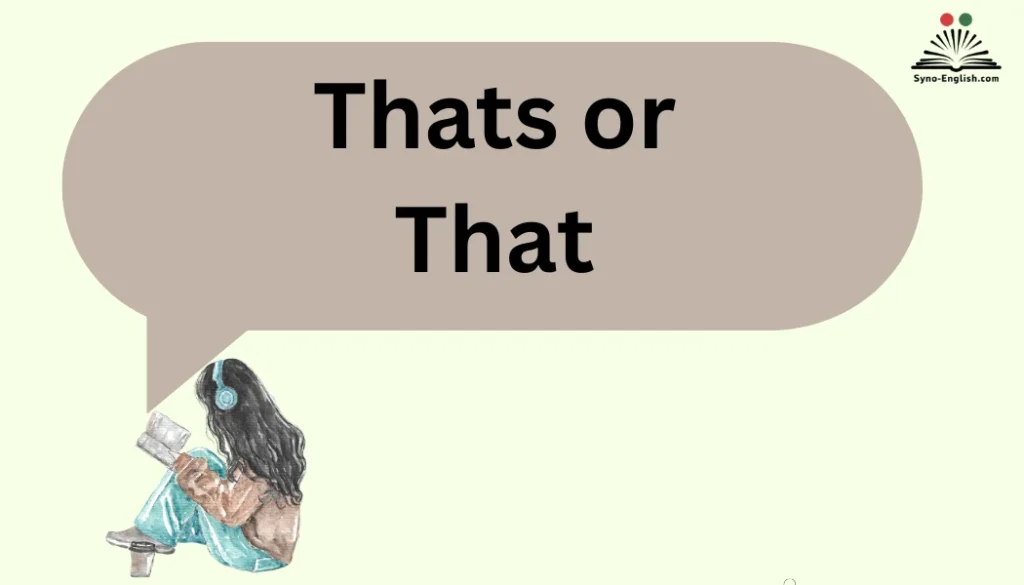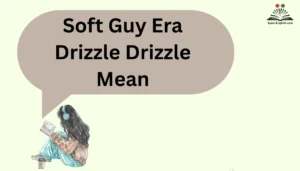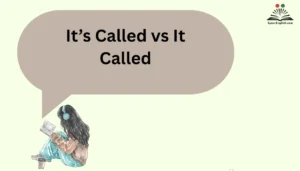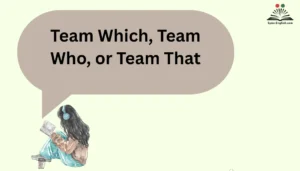The topic Thats or That’s Which Is Correct may sound simple, but the difference between them carries a huge weight in communication, and the apostrophe changes everything in grammar, usage, and context. I’ve often hesitated before typing a sentence, wondering if the correct form was That’s or Thats.
Many writers, students, and professionals have tripped up on this common mistake. However, a well-written guide with examples and explanations can help find clarity and confidence in English writing.In English, That’s (with an apostrophe) is a short way of saying “that is” or “that has,” and it belongs in a sentence where a contraction is needed. On the other hand, Thats without the mark almost never fits into proper writing.
The meanings and context change depending on when, how, and why you use each version. In my real-life editing work, I’ve learned that even a small symbol can shape tone, prevent confusion, and keep communication clear.
Understanding the Core Difference: “That’s” vs. “Thats”
At its heart, the debate is simple:
- That’s = a contraction of that is or that has.
- Thats = incorrect in standard English (unless part of a brand name, like Honda That’s).
The apostrophe replaces missing letters in contractions. Without it, the word loses its grammatical integrity.
Quick tip: If you can replace the word with that is or that has, then you need the apostrophe.
Example:
- Correct: That’s my favorite book. (That is my favorite book.)
- Incorrect: Thats my favorite book.
The Two Functions of “That’s”
“That’s” as a Contraction of “That Is”
This is the most common form. Anytime you want to shorten that is, you use that’s.
Examples in everyday English:
- That’s a brilliant idea. (That is a brilliant idea.)
- I think that’s the reason she left early.
- That’s what I’ve been saying all along.
Notice how conversational these sentences sound. If you expand them to that is, they feel slightly more formal, but still correct.
When to use it:
- Casual writing (text messages, blogs, conversations).
- Formal writing when the tone allows contractions (articles, speeches, essays).
“That’s” as a Contraction of “That Has”
Less common but equally important, that’s can also mean that has.
Examples:
- That’s been the hardest part of the project. (That has been the hardest part.)
- I know that’s happened before. (That has happened before.)
- That’s taken longer than expected.
How to spot the difference:
If the sentence includes a past participle (been, done, taken, happened), the contraction usually means that has.
Everyday Usage and Examples
The correct form shows up everywhere—spoken language, professional documents, and even literature. Let’s break it down:
Casual speech and texting:
- That’s hilarious 😂
- That’s why I couldn’t come last night.
Professional writing:
- That’s the procedure outlined in the manual.
- The report confirms that’s the policy moving forward.
Academic writing:
Contractions are sometimes avoided in academic essays, but if used, that’s remains correct. Just keep in mind that some professors prefer the full form (that is or that has).
Why People Mistakenly Write “Thats”
Despite being incorrect, “Thats” shows up constantly online. Why?
- Typing habits: Many people type fast and skip apostrophes to save time.
- Digital shortcuts: Phones and computers don’t always autocorrect “Thats.”
- Apostrophe confusion: English learners especially struggle with contractions and possessives.
Case study: Social media usage
A quick scan of Twitter and TikTok shows thousands of instances of “Thats” every day. Most users know it’s wrong but post quickly without correcting it. The same happens in text messaging, where speed matters more than grammar.
Why Correct Grammar Matters
You might wonder, “Does a missing apostrophe really matter?” The answer is yes—especially in professional and academic settings.
Clarity in Communication
An apostrophe signals missing letters. Without it, meaning can blur. For example:
| Incorrect | Correct | Expanded Form |
| Thats confusing | That’s confusing | That is confusing |
| Thats happened before | That’s happened before | That has happened before |
A tiny punctuation mark separates sloppy from clear writing.
Professional Credibility
Employers, professors, and clients often judge attention to detail by grammar. A missing apostrophe can make your writing look careless.
Quote from William Zinsser, author of On Writing Well:
“Clutter is the disease of American writing. We are a society strangling in unnecessary words, circular constructions, pompous frills, and meaningless jargon.”
If a missing apostrophe counts as clutter or laziness, it can undermine trust in your professionalism.
Digital Impact
- Spell-check and autocorrect: Many tools flag “Thats” as wrong.
- SEO (Search Engine Optimization): Misspelled words can affect how your content is indexed and discovered.
- Branding: Businesses that misuse grammar risk damaging credibility.
Special Case: Honda That’s
Here’s where the rules bend. The Honda That’s is a Japanese kei car launched in 2002 and discontinued in 2007. The name doesn’t include an apostrophe—intentionally.
Why? Branding. Companies often stylize names in ways that break grammar rules for design, recognition, or simplicity.
Key details about Honda That’s:
- Released: 2002
- Type: Kei car (small city car)
- Market: Japan only
- Discontinued: 2007
- Known for: Boxy design and compact practicality
Lesson: Proper nouns (names of products, brands, or titles) don’t have to follow grammar rules. Just because Honda dropped the apostrophe doesn’t mean you should.
Quick Reference Guide (Cheat Sheet)
Here’s a simple way to check yourself:
| Phrase | Correct or Incorrect | Why |
| Thats my phone. | ❌ Incorrect | Missing apostrophe |
| That’s my phone. | ✅ Correct | Contraction of “that is” |
| Thats been a long day. | ❌ Incorrect | “That has” requires apostrophe |
| That’s been a long day. | ✅ Correct | Contraction of “that has” |
Memory trick: Ask yourself—can I replace it with that is or that has? If yes, you need the apostrophe.
Conclusion
Understanding the difference between Thats and That’s is more than just a small grammar rule — it’s a reflection of how precision strengthens communication. The apostrophe in That’s isn’t just a punctuation mark; it shows clarity, ownership, and proper usage in English writing. Many writers, students, and professionals have been tripped up by this common mistake, but once you learn the correct form, your confidence in expressing ideas grows. The weight of this rule lies in its ability to make context clear, whether you’re typing a message or crafting a formal document.
In real-life situations, even a tiny difference like this can change the meanings of your sentence and alter how readers perceive your words. From the Honda That’s car example to everyday writing, understanding when, how, and why to use the right form is vital. Remember — That’s means “that is” or “that has,” while Thats is almost never used in formal English. Paying attention to these forms helps keep your writing sharp, correct, and clear. Over time, these small distinctions lead to a stronger sense of grammar, greater confidence, and a polished communication style that truly stands out.
FAQs
What is the main difference between “Thats” and “That’s”?
“That’s” has an apostrophe and means “that is” or “that has.” “Thats” is incorrect in formal English writing.
Why is the apostrophe important in “That’s”?
The apostrophe shows a contraction, helping make your sentence grammatically correct and clear.
Can I use “Thats” in casual messages?
You might see “Thats” in texts, but it’s not proper English and should be avoided in formal writing.
What type of error is confusing “Thats” and “That’s”?
It’s a grammatical mistake that affects clarity and correctness.
Why do writers often get confused?
Because the words sound identical, making the written difference easy to overlook.
How can I remember when to use “That’s”?
If you can replace it with “that is” or “that has,” use “That’s.”
Does “Thats” ever appear correctly?
Only in rare cases, such as names like “Honda That’s car.”
How does using “That’s” improve writing?
It makes your sentences precise, professional, and grammatically accurate.
Is it okay to mix them in one sentence?
Yes, but only if both serve their correct grammatical purposes.
What’s the easiest way to avoid this mistake?
Read your writing aloud; if “that is” fits naturally, then “That’s” is the correct choice.

Emma Brooke is a passionate English educator, writer, and language enthusiast with over a decade of experience helping learners master the nuances of the English language. At SynoEnglish, she blends practical grammar advice with real-world communication tips to make English easier, clearer, and more enjoyable for readers of all levels.



